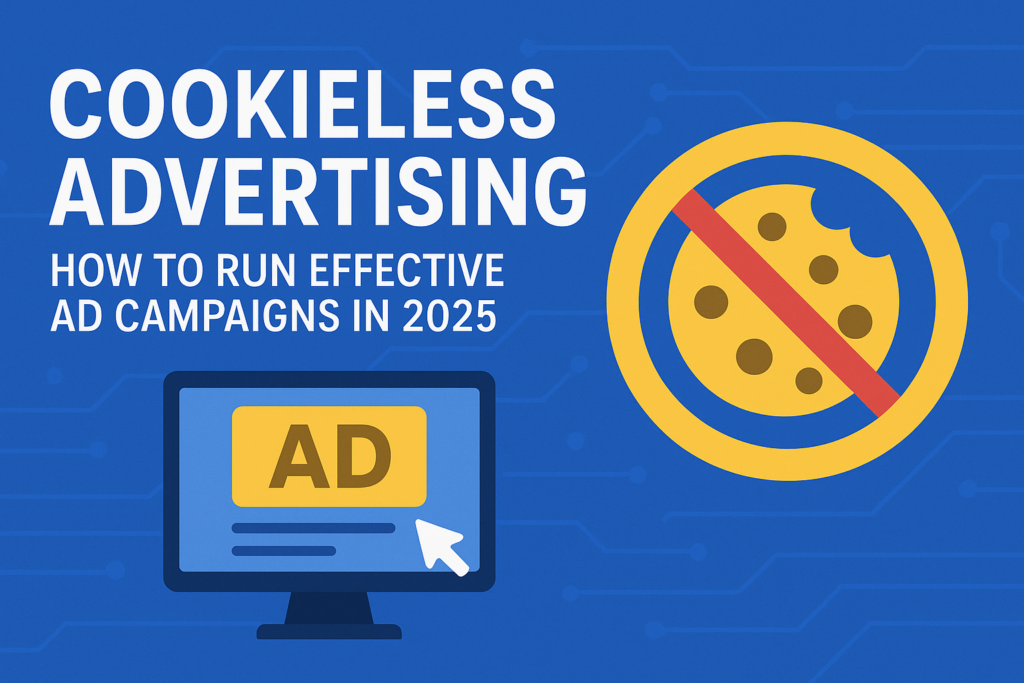
Table of Contents
Introduction: Cookieless Advertising
As we move into 2025, digital marketers face a major shift with increasing privacy regulations and the gradual elimination of third-party cookies. Cookieless advertising has emerged as the solution for running effective ad campaigns while respecting user privacy.
Cookieless advertising allows businesses to target audiences, personalize messaging, and optimize campaigns without relying on invasive tracking technologies. By adopting this approach, marketers can maintain efficiency, build trust, and comply with global and Indian privacy standards.
In this blog, we will explore how to run successful ad campaigns in a cookieless world and why this strategy is critical for 2025.
What is Cookieless Advertising?
Cookieless advertising refers to ad targeting and campaign optimization methods that do not rely on third-party cookies. Instead, marketers use:
- First-party data collected directly from users
- Contextual targeting based on content and audience behavior
- Privacy-compliant tracking technologies
- AI and predictive analytics for personalization
This approach ensures privacy compliance while still delivering relevant ads to the right audience.
Why Cookieless Advertising Matters in 2025
The shift to cookieless advertising is driven by privacy concerns, evolving regulations, and changes in consumer behavior. Key reasons to adopt this strategy include:
- Privacy Compliance: Aligns with GDPR, CCPA, and emerging Indian privacy laws.
- Increased Consumer Trust: Users prefer brands that respect their data.
- Better Data Quality: First-party data is more accurate and reliable.
- Future-Proof Strategy: Prepares businesses for a world without third-party cookies.
- Enhanced Campaign Performance: Contextual targeting and AI improve engagement and conversions.
Adopting cookieless advertising ensures brands stay ahead of competitors while maintaining ethical marketing practices.
Key Strategies for Cookieless Advertising
To run successful campaigns in 2025, marketers should use the following cookieless advertising strategies:
1. Leverage First-Party Data
- Collect data directly from your website, apps, and CRM.
- Use email subscriptions, loyalty programs, and user registrations to build profiles.
- Example: Personalized email campaigns based on past purchases.
2. Use Contextual Targeting
- Place ads based on the content the user is engaging with, not their browsing history.
- Example: Displaying fitness equipment ads on health and wellness articles.
3. Implement AI and Predictive Analytics
- AI tools analyze audience behavior patterns to deliver relevant ads.
- Predictive analytics helps anticipate customer needs without cookies.
4. Focus on Consent-Based Marketing
- Collect user consent for data collection to enhance targeting accuracy.
- Respect opt-in preferences to build trust.
5. Collaborate with Privacy-Friendly Ad Networks
- Use networks that specialize in cookieless advertising solutions.
- Ensure compliance with privacy regulations and improve ad delivery.
Best Tools for Cookieless Advertising
Agencies and businesses can rely on several tools for cookieless advertising campaigns:
- Google Privacy Sandbox: Offers cookieless solutions for ad targeting.
- Facebook Conversions API: Tracks conversions while respecting user privacy.
- AdRoll & Criteo: Contextual and AI-driven advertising networks.
- HubSpot & Salesforce Marketing Cloud: First-party data and CRM-based targeting.
Using these tools helps run effective campaigns without compromising privacy.
Benefits of Cookieless Ad Strategy
Adopting cookieless advertising provides several advantages:
- Enhanced Privacy Compliance: Avoid penalties and fines from privacy regulations.
- Improved Customer Trust: Transparent data practices build long-term loyalty.
- Accurate Targeting: First-party data delivers more precise insights.
- Sustainable Marketing Strategy: Future-proof campaigns against regulatory changes.
- Better ROI: Engaged and opted-in audiences improve conversion rates.
Challenges of Cookieless Ad Strategy and How to Overcome Them
Even though cookieless advertising offers benefits, marketers may face challenges:
- Reduced Targeting Precision: Third-party cookies are limited.
Solution: Focus on high-quality first-party data and contextual targeting. - Learning Curve: Adapting to new tools and strategies can be complex.
Solution: Invest in training and experimentation with AI and predictive analytics. - Tracking Campaign Performance: Some metrics may be less granular.
Solution: Use cookieless-friendly analytics platforms and conversion APIs.
By addressing these challenges, businesses can maintain effective and compliant ad campaigns.
Future of Cookieless Advertising
The future of Cookieless Ad Strategy is promising. Marketers will increasingly rely on:
- AI-driven personalization and automation
- Contextual ad networks and privacy-compliant platforms
- First-party data collection and consent-based marketing
- Predictive analytics to understand user intent
Agencies in India that embrace cookieless advertising early will gain a competitive edge, improve engagement, and stay compliant with evolving regulations.
About Ineffable Business Service
At Ineffable Business Service, we specialize in helping brands leverage the full potential of video marketing to create a powerful digital identity. From concept creation to production and distribution, our team delivers tailored video strategies that drive visibility, engagement, and growth. We understand that every business has a unique story to tell, and through our customized approach, we ensure your brand’s message reaches the right audience in the most impactful way. Partner with Ineffable Business Service today and experience firsthand how video marketing can transform your brand presence online.
Conclusion
Cookieless Ad Strategy represents the future of digital marketing. By focusing on first-party data, contextual targeting, AI tools, and privacy compliance, businesses can run effective ad campaigns in 2025 and beyond.
This approach not only ensures regulatory compliance but also enhances trust, improves ROI, and prepares agencies for a fully privacy-centric digital landscape. Embracing cookieless advertising today is the key to sustainable, long-term marketing success.
FAQs
1. What is Cookie-Free Advertising?
Cookieless advertising is running ad campaigns without relying on third-party cookies, using first-party data, contextual targeting, and AI analytics.
2. Why is Cookie-Free Advertising important in 2025?
Privacy regulations and consumer expectations are driving the need for privacy-friendly ad targeting.
3. How can businesses collect first-party data?
Use email subscriptions, loyalty programs, CRM systems, and website registrations.
4. Are cookieless campaigns as effective as traditional campaigns?
Yes, when using first-party data, contextual targeting, and AI analytics, campaigns can achieve similar or better results.
5. What tools help with Cookie-Free Advertising?
Google Privacy Sandbox, Facebook Conversions API, AdRoll, Criteo, and HubSpot are popular options.
